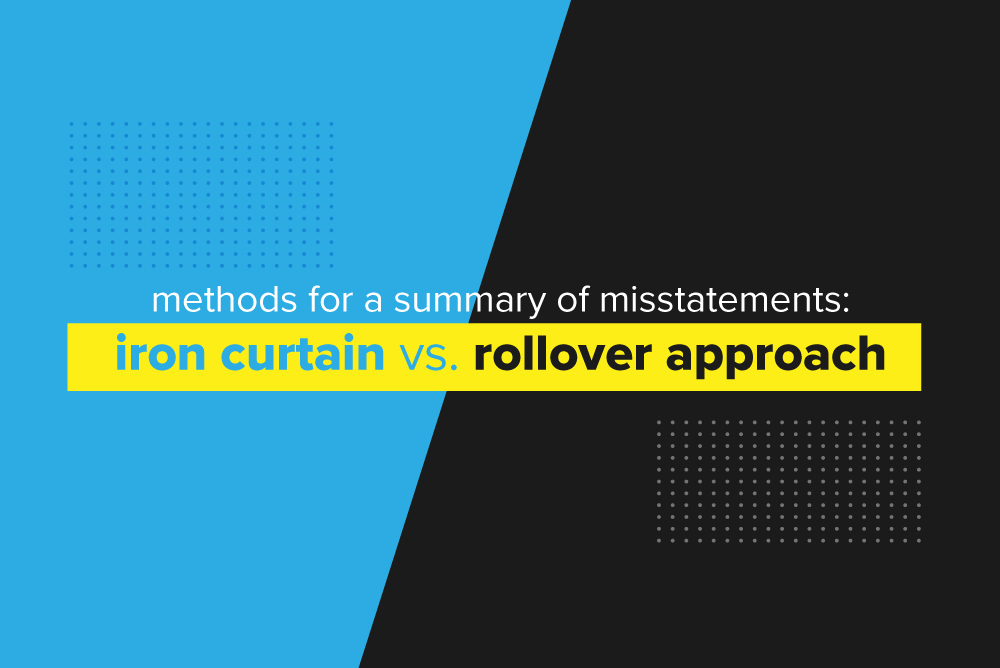Here’s a brain teaser for all of our Embarkites – which one actually matters?
- There's more than one way to crack an egg
- There's more than one way to tie a shoe
- There's more than one way to replace the radiator hose on a 1976 Chevy Vega
- There's more than one way to summarize misstatements on a recently concluded audit

Assuming your SAT hats still fit, let’s go through the choices. A poorly cracked egg will at worst leave some shell in your cookie dough, an untied shoe might make you trip but you’ll survive, and the Chevy Vega is bound to implode on the expressway any minute now so the radiator hose is the least of your problems. That leaves the summary of misstatements uncovered by an audit, and it definitely matters.
Whether you call them misstatements or past adjustments, auditors are required to use two distinctly different ways to calculate and present them – the iron curtain and rollover methods. Although they might sound more like a cage match between pro wrestlers than methods for an auditor to present misstatements, Embark is here to assure you that nothing could be further from the truth. In fact, give us a moment of your time and we’ll walk through an explanation and simple case study to demonstrate the differences between the two and shed some much-needed light on the subject.
A Brief Description
Every time an audit concludes, an auditor is required to present a summary of misstatements, sometimes referred to as a summary of past adjustments. This summary includes all misstated items found throughout the audit that are more significant than de minimis but not considered material.
To put it another way, these are actual errors or extrapolated errors uncovered by the audit that are serious but not considered substantial enough to impact the accuracy of the financial statements negatively. Still, the auditors must show how these misstatements would affect the financials if they were included and can choose between the iron curtain and rollover methods for such a task.
Simply put, the iron curtain method is balance sheet driven, ensuring the adjusted balance sheet as of year end is accurate and adequately reflects the misstatements while leaving the P&L susceptible to inaccuracies. Alternatively, the rollover method adjusts the YTD P&L for accuracy by integrating the adjusted figures but at the sacrifice of an accurate balance sheet.
In that sense, the terms rollover and iron curtain are somewhat counterintuitive, a notion that is critical in correctly understanding and using each. The rollover method isolates the current year’s misstatement while the iron curtain method accumulates the misstatement on an adjusted balance sheet over time. Yes, we recognize that seems backward but don’t shoot the messenger.
Although audit committees or management typically don't prefer one method over the other, auditors must be equally adept at both, calculating each method in their documentation but for SEC filers only presenting the one that yields the most significant cumulative impact on the P&L. But enough of that – let’s throw around some simple numbers for a better understanding.
A Simple Case Study
To demonstrate the impact of each of the methods over time, let’s look at a simple case study. Suppose, for instance, there’s a company with $10,000 annual revenue that consistently overstates expenses by $100 per year over the course of five years, as identified by their auditor. Although the $100 misstatement is the same no matter which method the auditor ultimately presents, the impact of those two methods varies over time.
When preparing the summary of misstatements, the auditor generates an adjusted P&L via the rollover method, effectively isolating the amount of error identified by the current year’s audit. Therefore, the rollover method consistently identifies a $100 misstatement that remains 1% of total revenue assuming all factors remain unchanged.
According to the iron curtain method, however, each identified $100 misstatement accumulates on the balance sheet with subsequent years, leading to a $200 total misstatement in year two and, ultimately, a $500 misstatement reflected on the adjusted balance sheet in year five. That fifth-year figure now equates to 5% of total revenue rather than 1%, a potentially material amount.
Obviously, the two methods have different cumulative impacts on net income. To reiterate, the auditor presents whichever of the two has the most significant impact on the P&L in any given year so, therefore, must be equally comfortable with both. Now that you have a better understanding of the methods used for summaries of misstatements, go practice cracking eggs, tying shoes, and changing the radiator hose on a ‘76 Vega and we’ll call it a day.








